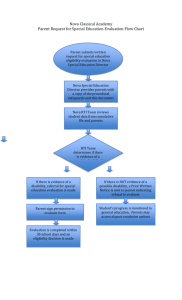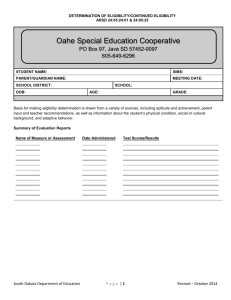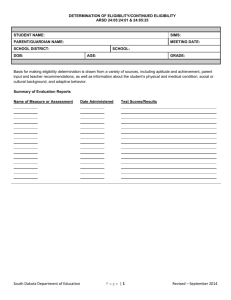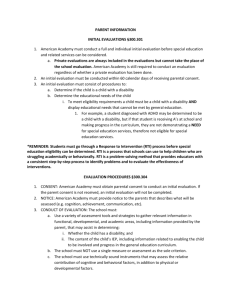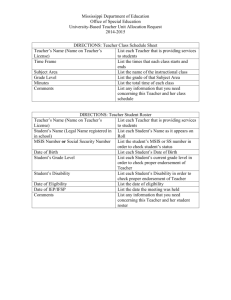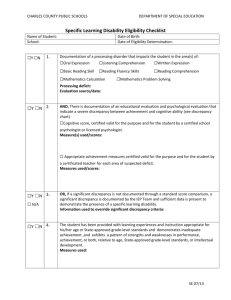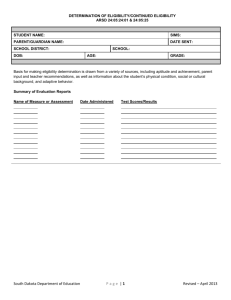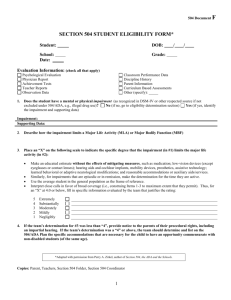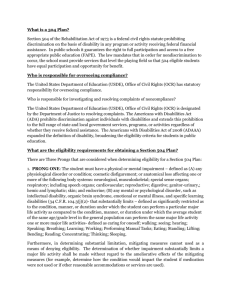Determination of Eligibility - Mid Central Education Cooperative
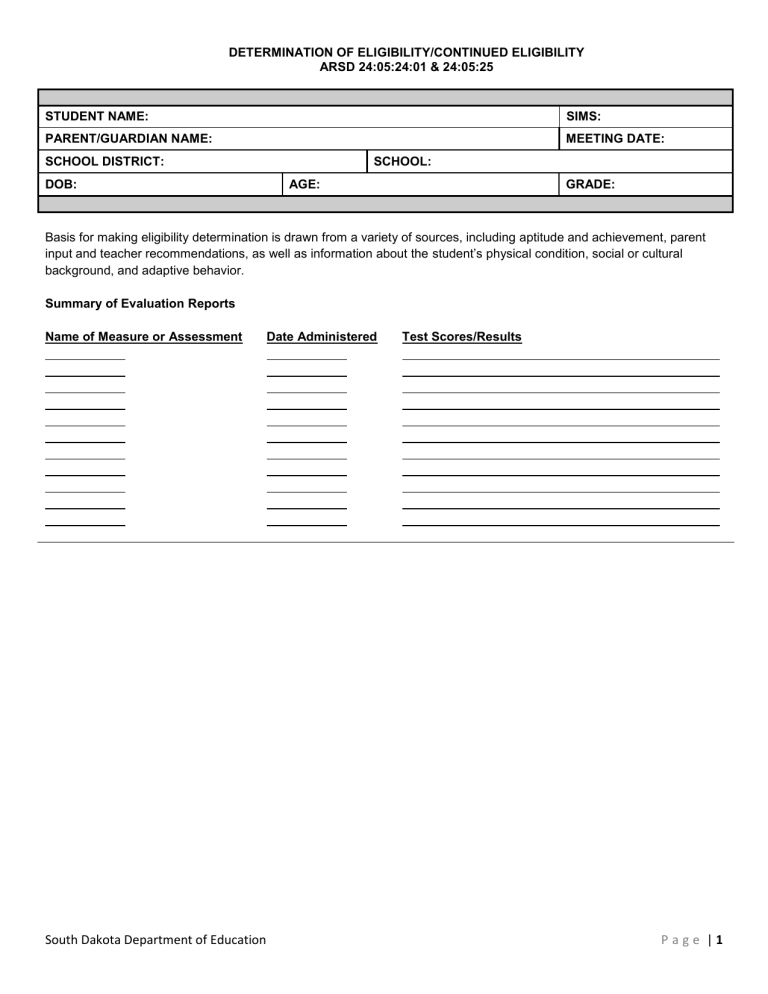
DETERMINATION OF ELIGIBILITY/CONTINUED ELIGIBILITY
ARSD 24:05:24:01 & 24:05:25
STUDENT NAME: SIMS:
PARENT/GUARDIAN NAME: MEETING DATE:
SCHOOL DISTRICT: SCHOOL:
DOB: AGE: GRADE:
Basis for making eligibility determination is drawn from a variety of sources, including aptitude and achievement, parent input and teacher recommendations, as well as information about the student ’s physical condition, social or cultural background, and adaptive behavior.
Summary of Evaluation Reports
Name of Measure or Assessment Date Administered Test Scores/Results
South Dakota Department of Education P a g e | 1 Revised – September 2014
DETERMINATION OF ELIGIBILITY/CONTINUED ELIGIBILITY
ARSD 24:05:24:01 & 24:05:25
Specific Learning Disabilities - 525
Check the appropriate box:
☐ RtI criteria will be used to determine eligibility
☐ Discrepancy criteria will be used to determine eligibility
(Required for RtI and Discrepancy)
Does the student achieve adequately for the student ’s age or to meet state-approved grade-level standards in one of more of the following areas, when provided with learning experiences and instruction appropriate for the student ’s age or state- approved grade-level standards
Subject area
Reading Comprehension
Basic Reading Skills
Does
☐
☐
Does not
☐
☐
Reading Fluency Skills
Mathematic Calculation
Mathematics Problem Solving
Written Expression
Oral Expression
☐
☐
☐
☐
☐
☐
☐
☐
☐
☐
Listening Comprehension ☐ ☐
(Required for RtI Only)
☐ Based upon the data gathered, the evaluation team determines the student has not made sufficient progress to meet age or state-approved grade-level standards in one or more of the areas identified above when using a process based on the student ’s response to scientific, research-based interventions.
OR
(Required for Discrepancy Only)
☐ The student exhibits a pattern of strengths and weaknesses in performance, achievement, or both, relative to age, state-approved grade level standards, or intellectual development, that is determined by the team to be relevant to the identification of a specific learning disability in one or more of the areas identified above when using appropriate assessments.
The Following Section Required only for Initial Eligibility Determination
(Required for RtI and Discrepancy)
Document data that demonstrates that prior to, or as part of, the referral process, the student was provided appropriate instruction in regular education settings by qualified personnel:
(Required for RtI Only)
Qualified Personnel:
Tier I
☐
II
☐
III
☐
Highly Qualified: Yes
☐
No
☐
Tier I ☐ II ☐ III ☐ Highly Qualified: Yes ☐ No ☐
Tier I ☐ II ☐ III ☐ Highly Qualified: Yes ☐ No ☐
Tier I ☐ II ☐ III ☐ Highly Qualified: Yes ☐ No ☐
Tier I
☐
II
☐
III
☐
Highly Qualified: Yes
☐
No
☐
Tier I ☐ II ☐ III ☐ Highly Qualified: Yes ☐ No ☐
Tier I ☐ II ☐ III ☐ Highly Qualified: Yes ☐ No ☐
South Dakota Department of Education P a g e | 2 Revised – September 2014
DETERMINATION OF ELIGIBILITY/CONTINUED ELIGIBILITY
ARSD 24:05:24:01 & 24:05:25
The Following Section Required only for Initial Eligibility Determination
(Required for RtI and Discrepancy)
Data-based documentation of repeated assessments of achievement at reasonable intervals, reflecting formal assessment of student progress during instruction, which was provided to the student ’s parents:
(Required for RtI Only)
Week 1: Date: Score: Week 2: Date: Score: Week 3: Date: Score:
Week 4: Date: Score: Week 5: Date: Score: Week 6: Date: Score:
Week 7: Date: Score: Week 8: Date: Score: Week 9: Date: Score:
Week 10: Date: Score: Week 11: Date: Score: Week 12: Date: Score:
Week 13: Date: Score: Week 14: Date: Score: Week 15: Date: Score:
Week 16: Date: Score: Week 17: Date: Score: *Week 18: Date: Score:
*Add additional data lines if needed
(Required for RtI and Discrepancy)
Attendance Record:
School Year: Total days of school: Total days in attendance:
Total days absent: Quarter 1: Quarter 2: Quarter 3: Quarter 4:
School Year: Total days of school: Total days in attendance:
Total days absent: Quarter 1: Quarter 2: Quarter 3: Quarter 4:
(Required for RtI and Discrepancy)
A student may not be determined to be a student with a disability if the determinant factor is a lack of appropriate instruction.
Is the underachievement of the student due to the lack of instruction in:
☐ Yes ☐ No – Reading
☐ Yes ☐ No – Math
(Required for RtI)
☐ Information from an observation in routine classroom instruction and monitoring of the student’s performance
OR was done before the student was referred for an evaluation.
(Required for Discrepancy)
☐ Observation of the student’s performance in the regular classroom was done after the student has been referred for an evaluation.
Observation: Relevant behaviors, if any, noted during the observation of the student and relationship of those behaviors to academic functioning. The observation must occur in the student’s learning environment (including regular classroom setting) to document the student’s academic performance and behavior in the areas of difficulty.
In the case of a student of less than school age or out of school, a group member must observe the student in an environment appropriate for a student of that age.
Observer:
Observation Comments:
Date of Observation:
South Dakota Department of Education P a g e | 3 Revised – September 2014
DETERMINATION OF ELIGIBILITY/CONTINUED ELIGIBILITY
ARSD 24:05:24:01 & 24:05:25
(Required for RtI and Discrepancy)
Document educationally relevant medical findings:
(Required for RtI and Discrepancy)
The evaluation team determines that the student ’s achievement level problem is/is not primarily the result of:
☐
Is
☐
Is Not - Visual, hearing or motor disabilities;
☐ Is ☐ Is Not – Cognitive disability;
☐ Is ☐ Is Not – Emotional disturbance;
☐ Is ☐ Is Not – Cultural factors;
☐ Is ☐ Is Not – Environmental or economic disadvantage;
☐ Is ☐ Is Not – Limited English proficiency.
THIS SECTION SHOULD ONLY BE COMPLETED IF USING
A STATE-APPROVED RESPONSE TO INTERVENTION MODEL
AND
RTI CRITERIA WILL BE USED TO DETERMINE ELIGIBILITY
If the student has participated in a process that assesses the student ’s response to scientific, research-based intervention document the following:
The instructional strategies used in the RtI process that assesses the student ’s response to scientific, research-based intervention:
The student has participated in weeks of Tier 3 interventions. (At least two phases of Tier 3 interventions to consider eligibility)
Tier 3 supports include minutes of core reading instruction (to include flexible reading small group time) and minutes of intensive, individualized intervention. The frequency of the interventions is times per week.
Researched-based intervention strategies (please list by type, not name).
Name of Research-based Intervention strategy: Duration of the intervention:
Universal Screening scores: Fall: Winter:
Actual rate of progress compared to benchmark standard:
Spring:
Grade level benchmark standard for end of school year:
Desired Rate of Progress: Predicted Rate of Progress:
Is the Predicted Rate of Progress significantly below grade level expectations? ☐ Yes ☐ No
South Dakota Department of Education P a g e | 4 Revised – September 2014
DETERMINATION OF ELIGIBILITY/CONTINUED ELIGIBILITY
ARSD 24:05:24:01 & 24:05:25
Specific Learning Disabilities - 525
List the adverse effects of the disability on student’s educational performance:
Based upon the above information the team agrees the student:
☐ has a specific learning disability.
☐ does not have a specific learning disability.
This report reflects my conclusions. If not, person(s) in disagreement will indicate such and must submit a separate statement.
Name Position
☐ Agree ☐ Disagree
☐ Agree
☐ Agree
☐
☐
Disagree
Disagree
☐ Agree
☐ Agree
☐ Agree
☐
☐
☐
Disagree
Disagree
Disagree
South Dakota Department of Education P a g e | 5 Revised – September 2014
DETERMINATION OF ELIGIBILITY/CONTINUED ELIGIBILITY
ARSD 24:05:24:01 & 24:05:25
Deaf-Blindness - 500
☐
Students may be identified as deaf-blind when both a vision and hearing impairment exists which causes such severe communication and other developmental and educational needs that they cannot be accommodated in special education programs solely for children with deafness or children with blindness.
If the above criteria are met, the student meets the definition of a student with deaf-blindness.
Emotional Disturbance - 505
The following characteristics are indicative of an emotional disturbance. Check those that apply: (student must exhibit one or more characteristics to meet criteria):
☐ An inability to learn which cannot be explained by intellectual, sensory or health factors.
☐ An inability to build or maintain satisfactory interpersonal relationships with peers and teachers.
☐ Inappropriate types of behavior or feelings under normal circumstances.
☐ A general pervasive mood of unhappiness or depression.
☐ A tendency to develop physical symptoms or fears associated with personal or school problems.
Emotional disturbance does not include social maladjustment, unless the student also has an emotional disturbance.
Emotional disturbance includes schizophrenia.
The following criteria must also be met:
☐
The student characteristics are exhibited serious behavior problems over a long period of time (not less than 6 months).
☐ Documentation from the school and one or more sources of the frequency & severity of the targeted behaviors.
☐ Student's performance falls 2 standard deviations below the mean in emotional functions as measured in school, home, and community on nationally formed technically adequate measures.
If the above criteria are met, the student meets the definition of a student with an emotional disturbance.
Cognitive Disability - 510
The following characteristics are indicative of a cognitive disability.
☐
General intellectual functioning 2 standard deviations or more below the mean as determined by the full scale score on an individual cognitive evaluation, plus or minus standard error of measurement.
☐ Exhibits deficits in adaptive behavior and academic or pre-academic skills as determined by an individual evaluation and manifested before age 18.
If the above criteria are met, the student meets the definition of a student with a cognitive disability.
Hearing Loss - 515
☐ A student may be identified as having a hearing loss if an unaided hearing loss of 35 to 69 decibels is present that makes the acquisition of receptive and expressive language skills difficult with or without the help of amplification.
If the above criteria are met, the student meets the definition of a student with a hearing loss.
Multiple Disabilities - 530
☐ Concomitant impairments (such as a cognitive disability-blindness or a cognitive disability-orthopedic impairment), the combination of which causes such severe educational needs that they cannot be accommodated in special education programs solely for one of the impairments. The term does not include deaf-blindness.
South Dakota Department of Education P a g e | 6 Revised – September 2014
DETERMINATION OF ELIGIBILITY/CONTINUED ELIGIBILITY
ARSD 24:05:24:01 & 24:05:25
If the above criteria are met, the student meets the definition of a student with multiple disabilities.
Orthopedic Impairment - 535
There must be evidence of the following:
☐
Severely impaired motor functioning that adversely affects educational performance; and
☐ Deficits in muscular or neuromuscular functioning that significantly limits the student's ability to move about, sit, or manipulate materials required for learning; and
☐ Student's bone, joint, or muscle problems affect ambulation, posture, or gross and fine motor skills; and
☐ Medical data by a qualified medical evaluator describes and confirms an orthopedic impairment.
If the above criteria are met, the student meets the definition of a student with an orthopedic impairment.
Vision Loss - 540
A deficiency in visual acuity shall be one of the following:
☐ Visual acuity of no better than 20/70 in the better eye after correction; or
☐
Restricted visual field; or
☐ Limited ability to move about safely in the environment due to a visual disability; or
☐ Blindness - Visual acuity of 20/200 or less in the better eye with correcting lenses or a limited field of vision such that the widest diameter subtends an angular distance of no greater that 20 degrees or has a medically indicated expectation of visual deterioration.
If the above criteria are met, the student meets the definition of a student with a vision loss.
Deafness - 545
☐ The unaided hearing loss is in excess of 70 decibels and precludes understanding of speech through the auditory mechanism, even with amplification, and demonstrates an inability in processing linguistic information through hearing, even with amplification.
If the above criteria are met, the student meets the definition of a student with deafness.
Speech or Language Disorder - 550
Articulation Disorder:
☐ Performance on a standardized articulation test falls 2 standard deviations below the mean & intelligibility is affected in conversation;
☐ Test performance is less than 2 standard deviations below the mean but the student is judged unintelligible by the speech language clinician and one other adult;
☐ Performance on a phonological assessment which falls in the profound or severe range & intelligibility is affected in conversation;
☐
Performance on a phonological assessment falls in the moderate range, intelligibility is affected in conversation, and during a tracking period of between 3 and 6 months there was a lack of improvement in the number and type of errors;
☐ An error persists 6 months to 1 year beyond the chronological age when 90% of students have typically acquired the sound based on developmental articulation norms.
South Dakota Department of Education P a g e | 7 Revised – September 2014
DETERMINATION OF ELIGIBILITY/CONTINUED ELIGIBILITY
ARSD 24:05:24:01 & 24:05:25
Fluency Disorder:
☐ The student consistently exhibits one or more of the following symptomatic behaviors of dysfluency:
☐ a) Sound, syllable, or word repetition;
☐ b) Prolongations of sounds, syllables, or words;
☐
c) Blockages; or
☐ d) Hesitations.
☐ There is a significant discrepancy from the norm (5 dysfluencies per minute) as measured by speech sampling in a variety of contexts; or
☐ The disruption occurs to the degree that the individual or persons who listen to the individual evidence reactions to the manner of speech and the disruptions so that communication is impeded.
Voice Disorder:
☐
Consistent deviations in one or more of the parameters of voice: pitch, quality, or volume exist; and
☐ The voice is discrepant from the norm as related to age, gender, and cultural and is distracting to the listener; and
☐ The disorder is not the result of a temporary problem such as: normal voice changes, allergies, colds, or other such conditions.
Language Disorder:
☐
Through age 8, performance falls 1.5 standard deviations below the mean on standardized evaluations;
☐ Beginning at age 9, a difference of 1.5 standard deviations between performance on a individually administered language assessment instrument and measured expected potential as measured by an individually administered intelligence test; and
☐ The student's pragmatic skill, as measured by checklists, language samples and/or observation, adversely affects the student's academic and social interactions
If the above criteria are met, the student meets the definition of a student with a speech (articulation, fluency, voice) or language impairment.
Other Health Impaired - 555
☐
Having limited strength, vitality or alertness, including a heightened alertness to environmental stimuli, that results in limited alertness with respect to the educational environment, that: Is due to chronic or acute health problems such as such as a heart condition, tuberculosis, rheumatic fever, nephritis, asthma, attention deficit disorder or attention deficit hyperactivity disorder, sickle cell anemia, hemophilia, epilepsy, lead poisoning, leukemia, Tourette syndrome, or diabetes
If the above criteria are met, the student meets the definition of a student with other health impairment.
Autism Spectrum Disorder- 560
An autism spectrum disorder is present in a student if the student expresses all three of the characteristics from subdivision (A), at least two characteristics from subdivision (B), and all of the characteristics in subdivision (C) through
(E), inclusive:
☐ A) Persistent deficits in social communication and social interaction across multiple contexts, as manifested by all of the following, currently or by history (examples are illustrative, not exhaustive; see text):
☐ 1. Deficits in social-emotional reciprocity, ranging, for example, from abnormal social approach and failure of normal back-and-forth conversation; to reduced sharing of interests, emotions, or affect; to failure to initiate or respond to social interactions.
☐ 2. Deficits in nonverbal communicative behaviors used for social interaction, ranging, for example, from poorly integrated verbal and nonverbal communication; to abnormalities in eye contact and body language or deficits in understanding and use of gestures; to a total lack of facial expressions and nonverbal communication.
South Dakota Department of Education P a g e | 8 Revised – September 2014
DETERMINATION OF ELIGIBILITY/CONTINUED ELIGIBILITY
ARSD 24:05:24:01 & 24:05:25
☐ 3. Deficits in developing, maintaining, and understand relationships, ranging, for example, from difficulties adjusting behavior to suit various social contexts; to difficulties in sharing imaginative play or in making friends; to absence of interest in peers.
☐ B) Restricted, repetitive patterns of behavior, interests, or activities, as manifested by at least two of the following, currently or by history (examples are illustrative, not exhaustive; see text):
☐ 1. Stereotyped or repetitive motor movements, use of objects, or speech (e.g., simple motor stereotypes, lining up toys or flipping objects, echolalia, idiosyncratic phrases).
☐
2. Insistence on sameness, inflexible adherence to routines, or ritualized patterns of verbal or nonverbal behavior (e.g., extreme distress at small changes, difficulties with transitions, rigid thinking patterns, greeting rituals, need to take same route or eat same food every day).
☐
3. Highly restricted, fixated interests that are abnormal in intensity or focus (e.g., strong attachment to or preoccupation with unusual objects, excessively circumscribed or perseverative interests).
☐ 4. Hyper- or hyporeactivity to sensory input or unusual interest in sensory aspects of the environment (e.g. apparent indifference to pain/temperature, adverse response to specific sounds or textures, excessive smelling or touching of objects, visual fascination with lights or movement).
☐ C) Symptoms must be present in the early developmental period (but may not become fully manifest until social demands exceed limited capacities, or may be masked by learned strategies in later life.)
☐ D) Symptoms cause clinically significant impairment in social, occupational, or other important areas of current functioning.
☐
E) These disturbances are not better explained by intellectual disability (intellectual development disorder) or global development delay. Intellectual disability and autism spectrum disorder frequently co-occur; to make comorbid diagnoses of autism spectrum disorder and intellectual disability; social communication should be below that expected for general developmental level.
If the above criteria are met, the student meets the definition of a student with autism spectrum disorder.
Traumatic Brain Injury - 565
☐ An acquired injury to the brain caused by an external physical force, resulting in a total or partial functional disability or psychosocial impairment, or both. The term applies to open or closed head injuries resulting in impairments in one or more areas, such as cognition; language; memory; attention; reasoning; abstract thinking; judgment; problem solving; sensory; perceptual; and motor abilities; psychosocial behavior; physical functions; information processing; and speech. The term does not apply to brain injuries that are congenital or degenerative, or brain injuries inducted by birth trauma.
If the above criteria are met, the student meets the definition of a student with a traumatic brain injury.
Developmental Delay - 570
The following characteristics are indicative of students 3, 4, or 5 years old that are in need of special education due to a developmental delay. Check those that apply:
☐ Functions at a developmental level 1.5 standard deviations below the mean in any two developmental areas; or
☐ Functions at a developmental level 2 standard deviation below the mean in any one area of development.
Check the areas of development:
☐ Adaptive Functioning Skills
☐ Cognitive Development
☐ Communication Development
☐
☐
Social and Emotional Development
Physical Development
If the above criteria are met, the student meets the definition of a student with developmental delay.
South Dakota Department of Education P a g e | 9 Revised – September 2014
DETERMINATION OF ELIGIBILITY/CONTINUED ELIGIBILITY
ARSD 24:05:24:01 & 24:05:25
Other Factors Considered:
A student may not be determined to be a student with a disability if the determinant factor is a lack of appropriate instruction.
Is the underachievement of the student due to the lack of instruction in:
☐ Yes ☐ No – Reading
☐ Yes ☐ No – Math
☐
Yes
☐
No – English Proficiency
Note: If Yes in any category above, the student is not a student with a disability (ARSD 24:05:25:04.03).
Eligibility Determination:
List the adverse effects of the disability on student’s educational performance:
☐ YES - The team agrees this student: a) has a diagnosed disability; b) the disability adversely affects the student ’s educational performance; and c) the student requires specifically designed instruction to receive a free appropriate public education.
☐ NO – The student is not eligible for special education or special education and related services.
The team determined this student meets eligibility criteria under the following category: (check the category that will be reported on student count)
☐ Deaf-Blindness - 500
☐ Emotional Disturbance - 505
☐ Cognitive Disability - 510
☐
☐
☐
Vision Loss - 540
Deafness - 545
Speech/Language- 550
☐ Hearing Loss - 515
☐ Specific Learning Disability - 525
☐ Other Health Impairment - 555
☐ Autism Spectrum Disorder - 560
☐ Multiple Disabilities (list category(s) of eligibility) -530 ☐ Traumatic Brain Injury - 565
☐ Orthopedic Impairment - 535 ☐ Developmental Delay - 570
List Categories for Multiple Disabilities:
For Autism Spectrum Disorder identify:
Social Communication Severity: ☐ Level 3 ☐ Level 2 ☐ Level 1
Restricted, Repetitive Behavior Severity: ☐ Level 3 ☐ Level 2 ☐ Level 1
South Dakota Department of Education P a g e | 10 Revised – September 2014
DETERMINATION OF ELIGIBILITY/CONTINUED ELIGIBILITY
ARSD 24:05:24:01 & 24:05:25
Related Service(s): Student therapy needs to be determined during IEP program development
Criteria for Occupational Therapy Services
1. The student has a disability requires special education;
2. The student needs occupational therapy to benefit from special education; and
3. The student must demonstrate performance on a standardized assessment instrument that falls at least 1.5 standard deviations below the mean in one or more of the following areas: fine motor skills, sensory integration, or visual.
Criteria for Physical Therapy Services
1. The student has a disability requires special education;
2. The student needs physical therapy to benefit from special education; and
3. The student must demonstrate performance on a standardized assessment instrument that falls at least 1.5 standard deviations below the mean on a standardized motor assessment instrument.
Speech – Language Pathology
1. To be provided as a related service, the IEP team must determine that the related service is required in order for the student to benefit from the special education program
South Dakota Department of Education P a g e | 11 Revised – September 2014

